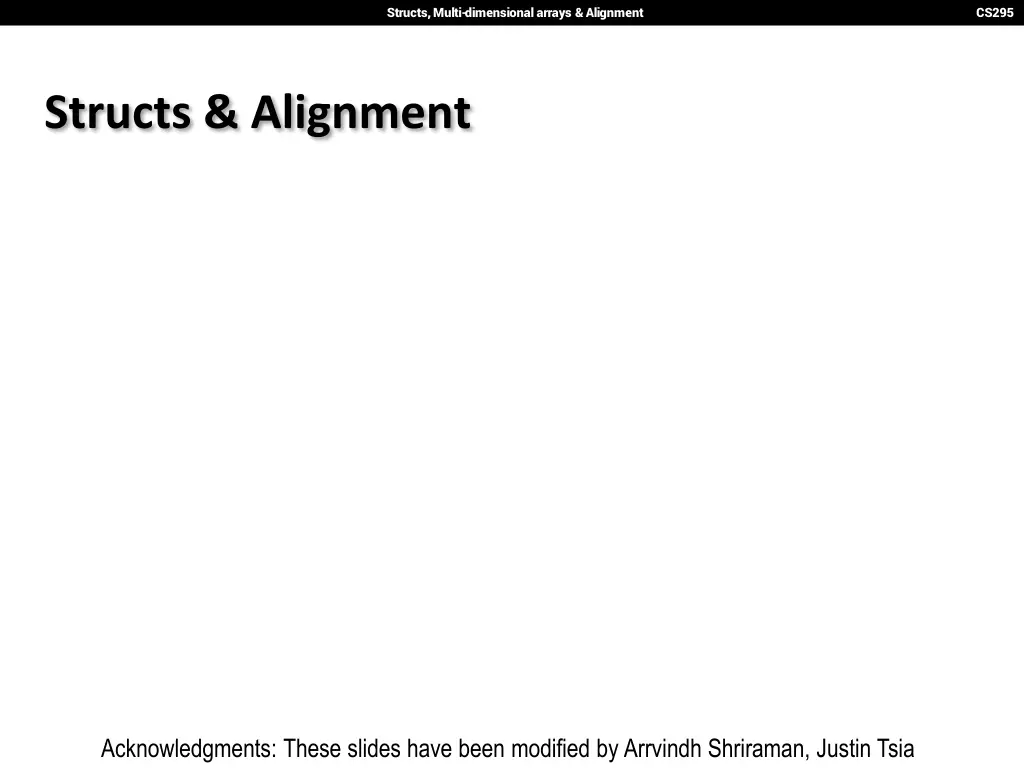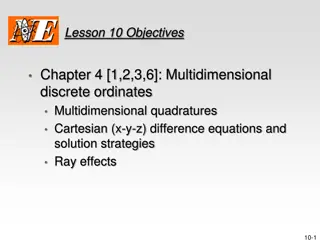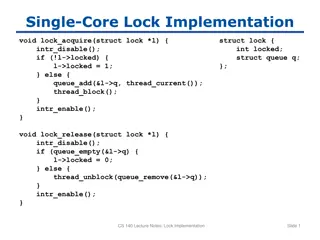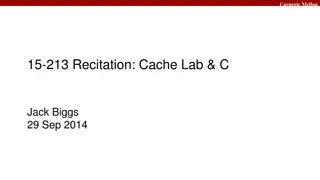
Understanding Structs, Multi-dimensional Arrays, and Alignment in CS295
Explore the concepts of structs, multi-dimensional arrays, and alignment in the context of CS295, covering topics such as array allocation, access principles, array examples, and details on arrays and functions in C. Gain insights into how these data structures are implemented and accessed efficiently. Acknowledgment to Arrvindh Shriraman and Justin Tsia for the content modifications.
Download Presentation

Please find below an Image/Link to download the presentation.
The content on the website is provided AS IS for your information and personal use only. It may not be sold, licensed, or shared on other websites without obtaining consent from the author. If you encounter any issues during the download, it is possible that the publisher has removed the file from their server.
You are allowed to download the files provided on this website for personal or commercial use, subject to the condition that they are used lawfully. All files are the property of their respective owners.
The content on the website is provided AS IS for your information and personal use only. It may not be sold, licensed, or shared on other websites without obtaining consent from the author.
E N D
Presentation Transcript
Structs, Multi-dimensional arrays & Alignment CS295 Structs & Alignment Acknowledgments: These slides have been modified by Arrvindh Shriraman, Justin Tsia
Structs, Multi-dimensional arrays & Alignment CS295 Data Structures in Assembly Arrays One-dimensional Multi-dimensional (nested) Multi-level Structs Alignment 2
Structs, Multi-dimensional arrays & Alignment CS295 Array Allocation Basic Principle T A[N]; array of data type T and length N Contiguously allocated region of N*sizeof(T) bytes Identifier A returns address of array (type T*) char msg[12]; x x + 12 int val[5]; x x + 4 x + 8 x + 12 x + 16 x + 20 double a[3]; x x + 8 x + 16 x + 24 char* p[3]; (or char *p[3];) x x + 8 x + 16 x + 24 3
Structs, Multi-dimensional arrays & Alignment CS295 Array Access Basic Principle T A[N]; array of data type T and length N Identifier A returns address of array (type T*) int x[5]; 3 7 1 9 5 a a+4 a+8 a+12 a+16 a+20 Value 5 a a + 4 a + 8 ?? (whatever s in memory at addr x+20) 7 a + 4*i Reference Type x[4] x x+1 &x[2] x[5] *(x+1) x+i int int* int* int* int int int* 4
Structs, Multi-dimensional arrays & Alignment CS295 Array Example typedefintzip_dig[5]; zip_dig cmu = { 1, 5, 2, 1, 3 }; zip_dig sfu = { 9, 8, 1, 9, 5 }; zip_dig ucb = { 9, 4, 7, 2, 0 }; initialization typedef: Declaration zip_dig sfu equivalent to int sfu[5] 5
Structs, Multi-dimensional arrays & Alignment CS295 C Details: Arrays and Pointers Arrays are (almost) identical to pointers char *stringand char string[]are nearly identical declarations Differ in subtle ways: initialization, sizeof(), etc. An array name looks like a pointer to the first (0th) element ar[0] same as *ar; ar[2] same as *(ar+2) An array name is read-only (no assignment) Cannot use "ar = <anything>" 7
Structs, Multi-dimensional arrays & Alignment CS295 C Details: Arrays and Functions Declared arrays only allocated while the scope is valid: char* foo() { char string[32]; ...; return string; } BAD! An array is passed to a function as a pointer: Array size gets lost! Reallyint *ar int foo(int ar[], unsigned int size) { ... ar[size-1] ... } Must explicitly pass the size! 8
Structs, Multi-dimensional arrays & Alignment CS295 typedef int zip_dig[5]; Referencing Examples zip_dig cmu; 1 5 2 1 3 16 20 24 28 32 36 zip_dig sfu; 9 8 1 9 5 36 40 44 48 52 56 zip_dig ucb; 9 4 7 2 0 56 60 64 68 72 76 Reference sfu[3] sfu[6] sfu[-1] cmu[15] Address 36 + 4* 3 = 48 36 + 4* 6 = 60 36 + 4*-1 = 32 16 + 4*15 = 76 Value 9 4 3 ?? Guaranteed? Yes No No No No bounds checking Example arrays happened to be allocated in successive 20 byte blocks Not guaranteed to happen in general 9
Structs, Multi-dimensional arrays & Alignment CS295 typedef int zip_dig[5]; Nested Array Example zip_dig sea[4] = {{ 9, 8, 1, 9, 5 }, { 9, 8, 1, 0, 5 }, { 9, 8, 1, 0, 3 }, { 9, 8, 1, 1, 5 }}; Remember, T A[N] is an array with elements of type T, with length N What is the layout in memory? same as: int sea[4][5]; 10
Structs, Multi-dimensional arrays & Alignment CS295 typedef int zip_dig[5]; Nested Array Example zip_dig sea[4] = {{ 9, 8, 1, 9, 5 }, { 9, 8, 1, 0, 5 }, { 9, 8, 1, 0, 3 }, { 9, 8, 1, 1, 5 }}; Remember, T A[N] is an array with elements of type T, with length N sea[3][2]; Row 2 Row 3 Row 0 Row 1 9 8 1 9 5 9 8 1 0 5 9 8 1 0 3 9 8 1 1 5 76 96 116 136 156 Row-major ordering of all elements Elements in the same row are contiguous Guaranteed (in C) 11
Structs, Multi-dimensional arrays & Alignment CS295 Two-Dimensional (Nested) Arrays Declaration: T A[R][C]; 2D array of data type T R rows, C columns Each element requires sizeof(T) bytes A[0][0] A[0][C-1] A[R-1][0] A[R-1][C-1] Array size? 12
Structs, Multi-dimensional arrays & Alignment CS295 Two-Dimensional (Nested) Arrays Declaration: T A[R][C]; 2D array of data type T R rows, C columns Each element requires sizeof(T) bytes A[0][0] A[0][C-1] A[R-1][0] A[R-1][C-1] Array size: R*C*sizeof(T) bytes Arrangement: row-major ordering int A[R][C]; A A A A A A [0] [0] [0] [C-1] [1] [0] [1] [C-1] [R-1] [0] [R-1] [C-1] 4*R*C bytes 13
Structs, Multi-dimensional arrays & Alignment CS295 Multi-Level Array Example Multi-Level Array Declaration(s): int cmu[5] = { 1, 5, 2, 1, 3 }; int sfu[5] = { 9, 8, 1, 9, 5 }; int ucb[5] = { 9, 4, 7, 2, 0 }; int* univ[3] = {sfu, cmu, ucb}; Is a multi-level array the same thing as a 2D array? NO 2D Array Declaration: zip_dig univ2D[3] = { { 9, 8, 1, 9, 5 }, { 1, 5, 2, 1, 3 }, { 9, 4, 7, 2, 0 } }; One array declaration = one contiguous block of memory 14
Structs, Multi-dimensional arrays & Alignment CS295 Array Element Accesses Nested array Multi-level array int get_sea_digit (int index, int digit) { return sea[index][digit]; } int get_univ_digit (int index, int digit) { return univ[index][digit]; } cmu 1 5 2 1 3 univ 16 20 24 28 32 36 36 sfu 160 9 8 1 9 5 16 168 36 40 44 48 52 56 ucb 60 176 9 4 7 2 0 60 64 68 72 76 80 Access looksthe same, but it isn t: Mem[Mem[univ+8*index]+4*digit] Mem[sea+20*index+4*digit] 15
Structs, Multi-dimensional arrays & Alignment CS295 Multi-Level Referencing Examples cmu 1 5 2 1 3 univ 16 20 24 28 32 36 sfu 36 160 9 8 1 9 5 16 168 176 36 40 44 48 52 56 ucb 60 9 4 7 2 0 60 64 68 72 76 80 Reference univ[2][3] univ[1][5] univ[2][-2] univ[3][-1] univ[1][12] C code does not do any bounds checking Location of each lower-level array in memory is not guaranteed Address Value Guaranteed? 16
Structs, Multi-dimensional arrays & Alignment CS295 Summary Contiguous allocations of memory No bounds checking (and no default initialization) Can usually be treated like a pointer to first element int a[4][5]; array of arrays all levels in one contiguous block of memory int* b[4]; array of pointers (to arrays) First level in one contiguous block of memory Each element in the first level points to another sub array Parts anywhere in memory 17
Structs, Multi-dimensional arrays & Alignment CS295 Data Structures in Assembly Arrays One-dimensional Multi-dimensional (nested) Multi-level Structs Alignment Unions 18
Structs, Multi-dimensional arrays & Alignment CS295 Structs in C Way of defining compound data types A structured group of variables, possibly including other structs typedefstruct { int lengthInSeconds; int yearRecorded; } Song; Song song1; song1.lengthInSeconds = 213; song1.yearRecorded = 1994; Song song2; song2.lengthInSeconds = 248; song2.yearRecorded = 1988; 19
Structs, Multi-dimensional arrays & Alignment CS295 Accessing Structure Members Given a struct instance, access member using the . operator: struct rec r1; r1.i = val; structrec { int a[4]; long i; structrec *next; }; Given a pointer to a struct: structrec *r; r = &r1; // or malloc space for r to point to We have two options: Use * and . operators: (*r).i = val; Use -> operator for short: r->i = val; In assembly: register holds address of the first byte Access members with offsets 20
Structs, Multi-dimensional arrays & Alignment CS295 Structure Representation structrec { int a[4]; long i; structrec *next; }; r i next 24 a 0 32 16 struct rec *r; Characteristics Contiguously-allocated region of memory Refer to members within structure by names Members may be of different types 21
Structs, Multi-dimensional arrays & Alignment CS295 Structure Representation structrec { int a[4]; long i; structrec *next; }; r i next 24 a 0 32 16 struct rec *r; Structure represented as block of memory Big enough to hold all of the fields Fields ordered according to declaration order Even if another ordering would be more compact Compiler determines overall size + positions of fields Machine-level program has no understanding of the structures in the source code 22
Structs, Multi-dimensional arrays & Alignment CS295 Accessing a Structure Member structrec { int a[4]; long i; structrec *next; }; r r->i i next 24 a 0 32 16 struct rec *r; long get_i(structrec *r) { return r->i; } Compiler knows the offset of each member within a struct Compute as *(r+offset) add a0, a1, 16 # Coming up in Week 3 ret Referring to absolute offset, so no pointer arithmetic 23
Structs, Multi-dimensional arrays & Alignment CS295 Generating Pointer to Array Element structrec { int a[4]; long i; structrec *next; }; r r+4*index i next 24 a 0 32 16 struct rec *r; int* find_addr_of_array_elem (structrec *r, long index) { return &r->a[index]; } Generating Pointer to Array Element Offset of each structure member determined at compile time Compute as: r+4*index &(r->a[index]) 24
Structs, Multi-dimensional arrays & Alignment CS295 Struct Definitions Structure definition: Does NOT declare a variable Variable type is struct name struct name { /* fields */ }; pointer Easy to forget semicolon! struct name name1, *pn, name_ar[3]; array Joint struct definition and typedef Don t need to give struct a name in this case struct nm { /* fields */ }; typedef struct nmname; name n1; typedef struct { /* fields */ } name; name n1;
Structs, Multi-dimensional arrays & Alignment CS295 Scope of Struct Definition Why is placement of struct definition important? What actually happens when you declare a variable? Creating space for it somewhere! Without definition, program doesn t know how much space Size = _____ bytes struct data { int ar[4]; long d; }; struct rec { int a[4]; long i; struct rec* next; }; Size = _____ bytes Almost always define structs in global scope near the top of your C file Struct definitions follow normal rules of scope 26
Structs, Multi-dimensional arrays & Alignment CS295 Nested Struct structfoo { long a; long b; struct barmy_bar; }; &f->my_bar &f->my_bar.y struct bar { long x; long y; }; a b x y 8 24 32 0 16 struct foo*f; 27
Structs, Multi-dimensional arrays & Alignment CS295 Nested Struct structfoo { long a; long b; struct foomy_foo; }; a b ????????? 8 0 16 28
Structs, Multi-dimensional arrays & Alignment CS295 Review: Memory Alignment Aligned means that any primitive object of ? bytes must have an address that is a multiple of ? Aligned addresses for data types: ? Type char short int, float long, double, * Addresses 1 No restrictions 2 Lowest bit must be zero: 02 Lowest 2 bits zero: 002 Lowest 3 bits zero: 0002 4 8 29
Structs, Multi-dimensional arrays & Alignment CS295 Alignment Principles Aligned Data Primitive data type requires ? bytes Address must be multiple of ? Motivation for Aligning Data Memory accessed by (aligned) chunks of bytes (width is system dependent) Inefficient to load or store value that spans quad word boundaries Virtual memory trickier when value spans 2 pages (more on this later) 30
Structs, Multi-dimensional arrays & Alignment CS295 Structures & Alignment structS1 { char c; int i[2]; double v; } *p; Unaligned Data c i[0] i[1] v p p+1 p+5 p+9 p+17 Aligned Data Primitive data type requires ? bytes Address must be multiple of ? c i[0] i[1] v 3 bytes 4 bytes p+0 p+4 p+8 p+16 p+24 Multiple of 4 Multiple of 8 Multiple of 8 Multiple of 8 internal fragmentation 31
Structs, Multi-dimensional arrays & Alignment CS295 Satisfying Alignment with Structures (1) structS1 { char c; int i[2]; double v; } *p; Within structure: Must satisfy each element s alignment requirement Overall structure placement Each structure has alignment requirement ?max ?max = Largest alignment of any element Counts array elements individually as elements Inner structs are aligned to their largest alignment Example: ?max = 8, due to double element c i[0] i[1] v 3 bytes 4 bytes p+0 p+4 p+8 p+16 p+24 Multiple of 4 Multiple of 8 Multiple of 8 internal fragmentation 32
Structs, Multi-dimensional arrays & Alignment CS295 Satisfying Alignment with Structures (2) structS2 { double v; int i[2]; char c; } *p; Can find offset of individual fields using offsetof() Need to #include <stddef.h> Example: offsetof(struct S2,c) returns 16 For largest alignment requirement ?max, overall structure size must be multiple of ?max Compiler will add padding at end of structure to meet overall structure alignment requirement v i[0] i[1] c 7 bytes p+0 p+8 p+16 p+24 Multiple of 8 Multiple of 8 external fragmentation 33
Structs, Multi-dimensional arrays & Alignment CS295 Arrays of Structures structS2 { double v; int i[2]; char c; } a[10]; Overall structure length multiple of ???? Satisfy alignment requirement for every element in array a[0] a[1] a[2] a+0 a+24 a+48 a+72 v i[0] i[1] c 7 bytes a+24 a+32 a+40 a+48 external fragmentation 34
Structs, Multi-dimensional arrays & Alignment CS295 Accessing Array Elements structS3 { short i; float v; short j; } a[10]; Compute start of array element as: 12*index sizeof(S3) = 12, including alignment padding Element j is at offset 8 within structure Assembler gives offset a+8 a[0] a[index] a+0 a+12 a+12*index i v j 2 bytes 2 bytes a+12*index a+12*index+8 short get_j(int index) { return a[index].j; } 35
Structs, Multi-dimensional arrays & Alignment CS295 Alignment of Structs Compiler will do the following: Maintains declared ordering of fields in struct Each fieldmust be aligned within the struct (may insert padding) offsetof can be used to get actual field offset Overall struct must be aligned according to largest field Total struct size must be multiple of its alignment (may insert padding) sizeof should be used to get true size of structs 36
Structs, Multi-dimensional arrays & Alignment CS295 How the Programmer Can Save Space Compiler must respect order elements are declared in Sometimes the programmer can save space by declaring large data types first struct S4 { char c; int i; char d; } *p; struct S5 { int i; char c; char d; } *p; c i d i c d 2 bytes 3 bytes 3 bytes 12 bytes 8 bytes 37
Structs, Multi-dimensional arrays & Alignment CS295 Peer Instruction Question Minimize the size of the struct by re-ordering the vars struct old { int i; struct new { int i; short s[3]; ______ ______; char *c; ______ ______; float f; }; ______ ______; }; What are the old and new sizes of the struct? sizeof(struct old) = _____ sizeof(struct new) = _____ 38
Structs, Multi-dimensional arrays & Alignment CS295 Summary Arrays in C Aligned to satisfy every element s alignment requirement Structures Allocate bytes in order declared Pad in middle and at end to satisfy alignment 39

















